Diamonds are beautiful, but how they’re placed in the ring influences their appearance. An ideal setting keeps the jewel secure, preventing it from rubbing against and damaging other stones. A good mount also keeps diamonds safe from chipping, while allowing light into the jewel to showcase its cut and clarity. A number of settings work as well on central jewels as they do on side stones, and others are particularly well suited for holding diamond side stones.
Prong Setting
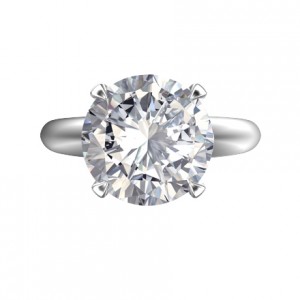 Those that use a series of thin wires to hold jewels in place, are a popular mount. The number of prongs used to secure a diamond may vary, with four to six prongs being common. These work well with almost any diamond cut, allowing plenty of light to travel through the stones. If you choose this mount and have selected a stone that contains sharp corners, make sure you receive V shaped prongs to protect the diamond.
Those that use a series of thin wires to hold jewels in place, are a popular mount. The number of prongs used to secure a diamond may vary, with four to six prongs being common. These work well with almost any diamond cut, allowing plenty of light to travel through the stones. If you choose this mount and have selected a stone that contains sharp corners, make sure you receive V shaped prongs to protect the diamond.
Bezel Setting
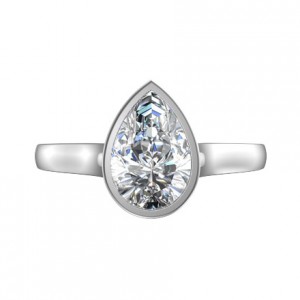 Uses a thin rim of metal wrapped around the jewel to keep it secure. This adds a decorative element, framing the stone with precious metal. Bezel mounts are also useful in protecting diamonds with thin girdles or pointed corners from chipping. People concerned about the security of their side stones may want to consider this setting.
Uses a thin rim of metal wrapped around the jewel to keep it secure. This adds a decorative element, framing the stone with precious metal. Bezel mounts are also useful in protecting diamonds with thin girdles or pointed corners from chipping. People concerned about the security of their side stones may want to consider this setting.
Channel Setting
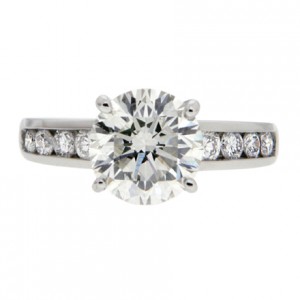 Start with a groove shaped into the ring band. Diamonds of uniform shape and size are placed in the gap, snugly fitting against one another. Rima of metal on either side of the groove are pressed over the diamonds, holding them in place. With this setting, the diamonds sit next to one another in a seamless fashion and are protected from chipping. Channel settings are best for rings with multiple side stones.
Start with a groove shaped into the ring band. Diamonds of uniform shape and size are placed in the gap, snugly fitting against one another. Rima of metal on either side of the groove are pressed over the diamonds, holding them in place. With this setting, the diamonds sit next to one another in a seamless fashion and are protected from chipping. Channel settings are best for rings with multiple side stones.
Pave Setting
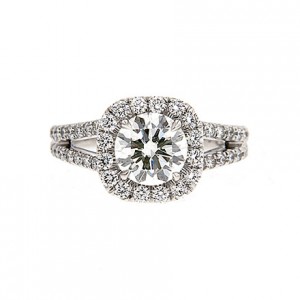 Is often used for the smallest of round diamonds. Tiny prongs molded into or carved from the ring hold a multitude of diamonds in place, packing them close together to create a surface covered entirely with jewels. The pave set is often used to add brilliance and luster to rings. Due to the diamonds’ size, they can be placed in areas too narrow for more substantial stones, as well as filling in larger spaces more finely than bigger diamonds. The pave setting is often used for halos as well as to brighten the shank of a ring.
Is often used for the smallest of round diamonds. Tiny prongs molded into or carved from the ring hold a multitude of diamonds in place, packing them close together to create a surface covered entirely with jewels. The pave set is often used to add brilliance and luster to rings. Due to the diamonds’ size, they can be placed in areas too narrow for more substantial stones, as well as filling in larger spaces more finely than bigger diamonds. The pave setting is often used for halos as well as to brighten the shank of a ring.
Bar Setting
Instead of prongs, a set of parallel bars holds the stone in place while leaving other sides around the jewel open.
Bead Setting
This variation on a prong setting holds stones in place with tiny burrs raised from the surrounding metal. Once they are pushed in place, these burrs are burnished and shaped into little balls.
Belcher Setting
This mounting is a cross between a bezel and prong set. Like a bezel, the stone sits flush with the surface of the metal. In the case of a Belcher however, the stone is held in place with prongs cut from the shank.
Bridge Accent Setting
This is the name for a tiny Bezel set gem, which is placed perpendicularly below the center stone in a ring. Hidden from view when a ring is looked at face up, turning the jewelry sideways reveals the accent.
Bright Cut Setting
This technique places a diamond on a reflective metal surface, the same material which is chiseled into prongs to secure the stone, before receiving an additional polish.
Claw Setting
T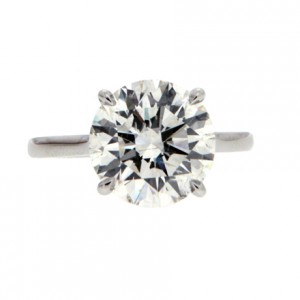 he prongs in this setting are fastened to the outside of the shank while the stone sits between a band on the inside of the shank and the claws. In this fashion, more light is able to travel through the gem.
he prongs in this setting are fastened to the outside of the shank while the stone sits between a band on the inside of the shank and the claws. In this fashion, more light is able to travel through the gem.
Common Prong Setting
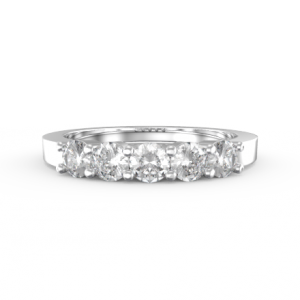 In this setting, prongs are tasked to hold more than one stone. The overall look has less metal to it, drawing more attention to the jewels.
In this setting, prongs are tasked to hold more than one stone. The overall look has less metal to it, drawing more attention to the jewels.
Half Bezel Setting
I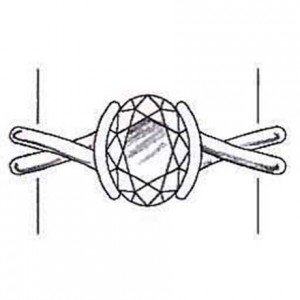 n which one or more bands of metal surrounds only part of a diamond to keep it secure. The rest of the stone remains open to light, increasing the diamond’s brilliance.
n which one or more bands of metal surrounds only part of a diamond to keep it secure. The rest of the stone remains open to light, increasing the diamond’s brilliance.
Scallop Setting
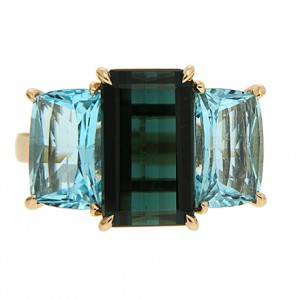 This version of a prong set fashions its claws from the shank, creating a curved effect.
This version of a prong set fashions its claws from the shank, creating a curved effect.
Trellis Setting
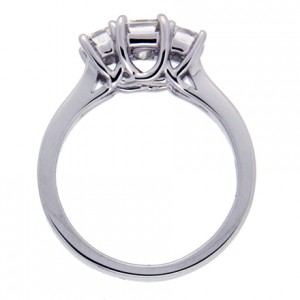 The Trellis is a prong set shaped into a decorative lattice work. The overlapping wires are visible from the side of a piece.
The Trellis is a prong set shaped into a decorative lattice work. The overlapping wires are visible from the side of a piece.
Illusion Setting
Give the impression of a diamond larger than its carat size. For people of a modest budget, an illusion setting can make their jewel seem more extravagant. The style of this setting has an additional benefit of adding brightness to both the stone and the mounting. An illusion set starts with a base of reflective metal, polished to a high sheen. The mount should be larger than the diamond, ensuring a bright perimeter. The gleam of the diamond blends in with the metal, providing the sense of a larger size. Some settings use mirror backings to give a diamond greater depth.
Invisible Setting
Invisible settings create the illusion of a gemstone resting on its mount without support. Van Cleef & Arpels patented the invisible setting in 1933, under the name “Mystery Set.” Usually more than one jewel is invisibly set, creating a plane of gemstones. The invisible set may be used on non-representational designs, as well as on flowers and other images, giving the impression of a jeweled world. Invisible settings are made by forming thin prongs on a mount. Notches are cut into the backs of the jewels. The gemstones are usually square, rectangular or trapezoidal, to better fit against their neighbors without gaps. The jewels are then fit onto the prongs, sitting snugly among the surrounding stones. An alternate method is to create channels of wire 0.2 centimeters in diameter or thinner, which must be strong enough to keep the jewels safe while remaining out of sight after setting.
Coronet Setting
This circular setting contains tall prongs that resemble a crown when viewed from the side.
Flush Setting
In this setting, a diamond is embedded in a hole drilled into the metal, placing the table at the same height as the metal’s surface. The edges of the hole are then pressed over the outer perimeter of the stone, holding it in place
Fishtail Setting
The name of this setting comes from the geometric prongs cut from the shank. When viewed from the side, the outline takes on a piscine shape.
Star Setting
As the name indicates, this decorative setting places a diamond into the middle of a star engraved into metal. The stone is then held in place with tiny prongs.
Tension Setting
In which a stone is held in place without prongs, a channel or bezel set, but with pressure. Tiny etchings are carved into the sides of the setting to accommodate a stone’s girdle and help keep the gem secure along with thousands of pounds per square inch. Due to the amount of force exerted on the stones, jewels of a Mohs hardness of 9 or greater are better suited for this form of setting.
Please Contact Us should you have any questions.





